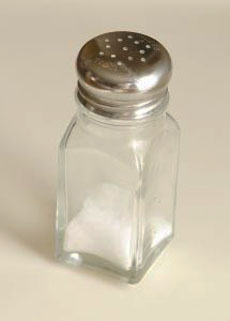Best Macaroni And Cheese
Page 3: Macaroni And Cheese Ingredients (A Big One Is Sodium!)
This is Page 3 of a 5-page article (plus ?? pages of boxed macaroni and cheese reviews). Click the black links below to view other pages.
The Sodium Blues
It was evident immediately that substantial sodium content was a fixture in boxed macaroni and cheese products. According to the Centers for Disease Control website, current dietary guidelines recommend that most adults should not consume more than 2,300 mg of sodium per day. If you are over 40, African American or have high blood pressure, that recommendation drops to a maximum of 1,500 mg per day.*
*Incidentally, the American Heart Association says that one in three adults in the U.S. has high blood pressure, so the lessened maximum sodium intake applies to a lot of people.
For children, the maximum suggested sodium intake is even less. According to the Mayo Clinic, kids 4-8 years old should ingest no more than 1,200 mg of sodium per day; that guideline number rises to 1,500 mg per day for children age 9 and older.
It’s not a secret that the majority of sodium in American diets is derived from packaged/processed, store-bought and restaurant foods. Even so, I was shocked by how much sodium many of these macaroni and cheeses contained. Perhaps that was foolish. After all, milk and cheese contain enough sodium to significantly raise levels in any dish containing both. But I was still unprepared for what I found. |
|
 Photo by Ramon Gonzalez | SXC. Photo by Ramon Gonzalez | SXC. |
For children, the maximum suggested sodium intake is even less. According to the Mayo Clinic, kids 4-8 years old should ingest no more than 1,200 mg of sodium per day; that guideline number rises to 1,500 mg per day for children age 9 and older.
*Incidentally, the American Heart Association says that one in three adults in the U.S. has high blood pressure, so the lessened maximum sodium intake applies to a lot of people.
It’s not a secret that the majority of sodium in American diets is derived from packaged/processed, store-bought and restaurant foods. Even so, I was shocked by how much sodium many of these macaroni and cheeses contained. Perhaps that was foolish. After all, milk and cheese contain enough sodium to significantly raise levels in any dish containing both. But I was still unprepared for what I found.
Sodium Content In Boxed Mac And Cheese
The Sodium Champions were Kraft Extreme Cheese Explosion Macaroni & Cheese Dinner and Wegman’s Extra Cheesy Shells & Cheddar Dinner, both with 1,030 mg of sodium per serving. Most products tested contained between 540 and 850 mg of sodium per serving, and serving sizes varied.
Kraft Microwavable Cheddar Explosion Macaroni & Cheese Dinner, for instance, contained 580 mg of sodium in a carton that yielded 1/2 cup prepared. Both Annie’s Homegrown Microwavable Macaroni & Cheese with Real Aged Cheddar and the same company’s Organic 5-Grain Elbows & White Cheddar contained 580 mg in a 3/4 cup serving and 1 cup serving, respectively.
Among the brands I tested, Annie’s Homegrown had the lowest average sodium levels. The average sodium level per serving of Annie’s Homegrown mac and cheese (stovetop varieties, prepared according to package directions) was 575.5 mg. Compare that to the average among prepared stovetop varieties of Pasta Roni (770 mg), Kraft Foods (770.95 mg) or Back to Nature (680 mg).
Again, with so many Americans consuming so much processed or prepackaged food, any restraint in sodium levels is laudable. Alas, unsurprisingly, microwavable varieties offered more sodium per comparably-sized serving. For instance, microwavable Annie’s Homegrown (Real White Cheddar) provides 570 mg of sodium per serving, but a serving is only about 3/4 cup. Similarly, Kraft Foods EasyMac White Cheddar contains 600 mg of sodium per serving, with one serving measuring approximately 2/3 cup.
Even ostensibly “healthier” versions of boxed macaroni and cheese weren’t exempt from high sodium levels. Fiber Gourmet’s Mac-mmm-Cheese contained 660 mg of sodium per about 1 cup prepared; Hodgson Mill Whole Wheat Macaroni & Cheese Dinner had 650 mg in the same quantity. And, of course, not everyone stops at one serving.
Annie’s Homegrown does offer a boxed macaroni and cheese with 25% less sodium, but by sheer chance it was one of the last products I tried. And after tasting so many higher-sodium versions of macaroni and cheese, a reduced-sodium version seemed very bland indeed.
Watch Your Sodium Intake
I expect macaroni and cheese to have some sodium content. But the sodium numbers I found bothered me greatly. If macaroni and cheese was the only packaged/processed/restaurant food Americans consumed, and if they only ate it occasionally, I wouldn’t be questioning these numbers. But we know that Americans eat a great deal of packaged/processed/restaurant food, and they eat it often. In particular, kids are heavy consumers of macaroni and cheese.
It would be worthwhile examining recipes for homemade macaroni and cheese to see how they measure up. Livestrong.com notes that a portion of homemade mac and cheese, from a recipe using a basic white sauce, 4 cups of shredded Cheddar and 4 tablespoons of butter, contains 594 mg of sodium per nearly a 1 cup serving.
In a nutshell, if you need to watch your sodium intake, you need to watch your intake of these products, too.
By the way, if your company comes up with a whole grain macaroni and cheese mix designed for a grown-up’s palate, with a sodium level that won’t cause dietitians to gasp in horror, please feel free to e-mail me and tell me about it.
Continue To Page 4: Testing Methodology & General Findings
Go To The Article Index Above
Lifestyle Direct Direct, Inc. All rights reserved. Images are the copyright of their respective owners.

|





